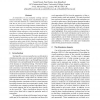52 search results - page 2 / 11 » Making Sense of Reference to the Unfamiliar |
SOUPS
2006
ACM
13 years 11 months ago
2006
ACM
Phishing emails are semantic attacks that con people into divulging sensitive information using techniques to make the user believe that information is being requested by a legiti...
COLING
2010
13 years 8 days ago
2010
Precision-oriented search results such as those typically returned by the major search engines are vulnerable to issues of polysemy. When the same term refers to different things,...
BMCBI
2010
13 years 5 months ago
2010
Background: Word sense disambiguation (WSD) algorithms attempt to select the proper sense of ambiguous terms in text. Resources like the UMLS provide a reference thesaurus to be u...
DAM
2011
13 years 8 days ago
2011
An edge-labeling λ for a directed graph G has a weak sense of direction (WSD) if there is a function f that satisfies the condition that for any node u and for any two label seq...
IV
2006
IEEE
13 years 11 months ago
2006
IEEE
As researchers we are constantly working with our literature domains. Making sense and familiarizing ourselves with such domains is a cumbersome but necessary task that is part of...

